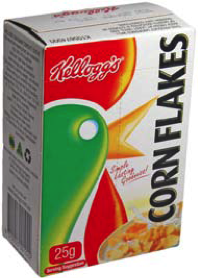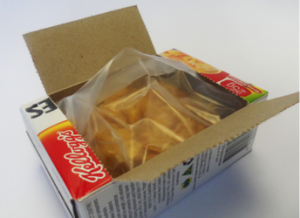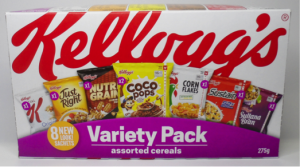Case study – Kellogg’s portion-controlled cereal range
Kellogg’s easy-to-open portion-controlled cereal range is a great example of innovative and accessible packaging. The low opening force and easy-to-read instructions, means that the packaging is easy-to-use for all consumers, including those with reduced strength and dexterity, as commonly experience by the ageing population and the arthritis community. The easy-to-open packaging has been designed with all consumers in mind and its success has seen the cereal varieties available with this packaging, expand.
The design was developed in collaboration with Arthritis Australia’s Accessible Design Division and their research partner Dr Brad Fain from the Georgia Tech Research Institute (GTRI). The Division assisted Kellogg’s throughout the redevelopment process and the range has now joined our Easy To Open Certified program.
Evolution of Kellogg’s portion-controlled cereal packaging:
Changing from old box format to new easy-to-open sachet format
The evolution from the former portion-controlled box design to the now easy-to-open sachet design was motivated to meet the changing needs of the market, including the need to make the product accessible for the broader community, and people living with arthritis.
Kellogg’s worked with Arthritis Australia’s Accessible Design Division to achieve this through an open and constant dialogue and prototype testing during the re-development process to ensure the new packaging was easy-to-open.
Range expansion: From foodservice to retail and the expanded cereal range
The Kellogg’s Easy to Open Certified sachet range has also increased the number of cereal varieties available with the new packaging format. As a result of the fun-pack varieties new format, product quantities sold through food service channels and retail have grown.
Benefits of the new Easy to Open Certified packaging design
Accessibility has added value to Kellogg’s range through the new design by providing greater capability to understand and meet diverse consumer needs. Due to the growing number of consumers who have arthritis as well as the ageing population, Kellogg’s recognised that there was a need to address accessibility in packaging for their products. It was a win-win for Kellogg’s business and made commercial, consumer and environmental sense to change to the new packaging design.

From the redesign process, Kellogg’s has begun integrating packaging accessibility into their development process of new products, such as exploring options to make packaging easier to tear and minimising adhesive in cartons based packaging to facilitate opening.
Sustainability benefits of the new design include a reduction in packaging and processing, by producing less greenhouse gas and using less energy overall which is minimising the company’s environmental impact. The sachet materials can also be recycled through the REDcycle, (Red Cycle labelling) program. Being easy-to-open also means the packaging contributes to the APCO Sustainable Packaging Guidelines to be ‘fit-for-purpose’.
The result of the new Easy to Open Certified sachet has been a successful design, which significantly improved its opening functionality from the previous box design, to meet the needs of the broader community.
Kellogg’s dedication to accessibility has been seen through their work with the Accessible Design Division and their decision to make the new packaging more readily available to the community through an increased product range.
The new design is a positive step forward for Kellogg’s understanding of how accessibility can be involved in the packaging development process and this has assisted the company in meeting changing market needs.
Discover more...
-
Children and arthritis
Arthritis can happen at any age. Here, you can find management and treatment information specifically created for the more than 6,000 Australian children living with...
-
What is accessible design?
Find out about what accessible design is and about the Accessible Design Division.
-
10 steps for living well with arthritis
Here is our 10 steps checklist to help you live with arthritis.
Sign up to Arthritis Insights
Regular updates, news and research findings delivered to your inbox:



